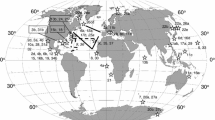Summary
The ostracod Cyprideis torosa Jones 1850 is a dominant species in brackish water habitats. To assess its importance, growth and respiration were measured. The shells form an increasing part of total weight as the animals grow but there is no correlation between shell weight and soft parts weight in the adults, indicating that tissue growth is a continuous process in these ostracods.
Respiration was measured at 20° C. The slope of the log-log regression of respiration on dry weight was 0.746, showing that Cyprideis torosa follows the general rule for this relationship. The respiration rate per unit biomass was 0.246 nl O2 μg-1 h-1, which is low but well within the range of observed meiobenthic respiration rates.
The Q10, expressing the temperature dependence of respiration, was 2.15. The general validity of Price and Warwick's (1980) hypothesis relating Q10 to stability of food supply is questioned.
Similar content being viewed by others
References
Anderson FW (1964) The law of ostracod growth. Palaeontology 7:85–104
Gillandt L (1977) Größenwachstum bei Ostracoden, untersucht an der Larvalentwicklung von Dypridopsis parvoides Martens 1977 (Crustacea, Ostracoda, Podocopida). Abh. Verh Naturwiss Ver Hamburg 20:99–112
Heip C (1976) The life-cycle of Cyprideis torosa (Curstacea, Ostracoda). Oecologia (Berl) 24:229–245
Heitkamp U (1979) Postembryonales Größenwachstum limnischer Cyprididae (Crustacea, Ostracoda). Zool Anz Jena 202:391–412
Hemmingsen AM (1960) Energy metabolism as related to body size and respiratory surfaces, and its evolution. Rep Steno Hosp (Kbh) 9:1–11
Ivleva IV (1980) The dependence of crustacean respiration rate on body mass and habitat temperature. Int Revue Gesamten Hydrobiol 65:1–47
Klekowski RZ (1971) Cartesian diver microrespirometry of aquatic animals. Pol Arch Hydrobiol 18:93–114
Lasker R, Wells JBJ, McIntyre AD. (1970) Growth, reproduction and carbon utilization of the sand-dwelling harpacticoid copepod, Asellopsis intermedia. J Mar Biol Assoc UK 50:147–160
McNeill S, Lawton JH (1970) Annual production and respiration in animal populations. Nature 225:472–474
Miller RJ, Mann KH (1973) Ecological energetics of the seaweed zone in a marine bay on the Atlantic coast of Canada. III. Energy transformations by sea urchins. Mar Biol 18:99–114
Price R, Warwick RM (1980) The effect of temperature on the respiration rate of meiofauna. Oecologia (Berl) 44:145–148
Teare M, Price R (1979) Respiration of the meiobenthic harpacticoid copepod, Tachidius discipes from an estuarine mudflat. J Exp Mar Biol Ecol 41:1–8
Vesper B (1972) Zur Morphologie und Ökologie von Cyprideis torosa Jones 1850 (Crustacea, Ostracoda, Cytheridae) unter besondere Berücksichtigung seiner Biometrie. Mitt Ham Zool Mus Inst 68:21–77
Warwick RM, Price R (1979) Ecological and metabolic studies on free-living nematodes from an estuarine mudflat. Estuarine Coastal Mar Sci 9:257–271
Author information
Authors and Affiliations
Rights and permissions
About this article
Cite this article
Herman, P.M.J., Heip, C. Growth and respiration of Cyprideis torosa Jones 1850 (Crustacea Ostracoda). Oecologia 54, 300–303 (1982). https://doi.org/10.1007/BF00379996
Received:
Issue Date:
DOI: https://doi.org/10.1007/BF00379996



